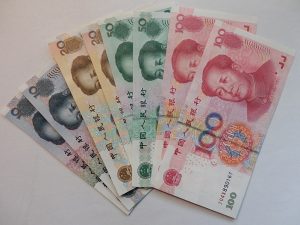China Renminbi Joins U.S. Dollar as Main World Currency Reserve

Creative Commons image by Alexmar983
Remember when the Yuan suffered sudden devaluation against the dollar and then the Chinese stock market crashed back in August?
Shock waves went through the global economy, leaving many asking what it all meant. Financial experts couldn’t agree. Well, it was all leading up to yesterday.
There’s a huge global economy news story this week involving, of course, China…
The International Monetary Fund (IMF) approved China’s renminbi as one of the world’s main central bank reserve currencies.
We usually think of the renminbi as the yuan because the yuan is the basic unit of the renminbi and often used internationally to refer to China’s currency.
But no matter what you’re accustomed to calling China’s currency, it has now joined the elite ranks of the dollar, the euro, the pound, and the yen as an IMF approved currency for Special Drawing Rights.
Special Drawing Rights is hard to explain. It’s a foreign exchange reserve made up of a basket of different currencies. It is not a currency in and of itself. You won’t find Special Drawing Rights notes anywhere, but Special Drawing Rights are held by IMF member countries as a claim to currency and can be exchanged for the currency types that make its basket. And only for those currencies.
There is a definite status that comes with being a country with a currency in this global reserve system. Of course, not all currencies in it are created equal.
The currencies in the Special Drawing Rights basket are weighted by prominence in international trade and national foreign exchange reserves, which the IMF assesses every five years. The U.S. dollar still significantly holds the most weight for the IMF, making it the biggest percentage of currency in the Special Drawing Rights basket.
It was a huge goal of Beijing’s to get the renminbi included in the Special Drawing Rights basket. Reaching that goal, and allowing the renminbi to play a larger role in international trade, forced China to give up some control over its currency. With that, comes some uncertainty for China’s economy.
China has already emerged as a world economic power, but seeing its currency become a world reserve currency might be a watershed moment for how the country handles its economic and monetary systems.
Some actually think this moment is a turning point for the whole global economy. But let’s not get too far ahead of ourselves just yet.
In order to see the renminbi get approved for this status by the IMF, China already had to adjust the way it handles its currency.
Ms. Christine Lagarde, Managing Director of the IMF, was quoted in an IMF press release yesterday (Monday, November 30th) announcing the decision to include China’s renminbi in the basket of currencies that make up the Special Drawing Rate:
“The Executive Board’s decision to include the RMB in the SDR basket is an important milestone in the integration of the Chinese economy into the global financial system. It is also a recognition of the progress that the Chinese authorities have made in the past years in reforming China’s monetary and financial systems. The continuation and deepening of these efforts will bring about a more robust international monetary and financial system, which in turn will support the growth and stability of China and the global economy.”
Those monetary and financial system reforms mentioned are what caused all the turmoil with the yuan and Chinese stock market back in August.
In the New York Times, Keith Bradsher gives a quick overview of China’s work to make the renminbi qualify for the IMF’s approval into the Special Drawing Rate’s basket of currencies:
To meet the I.M.F. requirements, China was forced to give up some of its tight control over the currency, culminating in the abrupt devaluation of the renminbi that shook global markets in August….
…
In the months before the fund’s decision, China moved aggressively to expand the currency’s standing on a global stage, building trading hubs in Europe and developing a raft of renminbi-denominated bonds and commodity contracts. In devaluing the currency, China changed the way it sets the value of the renminbi each morning, allowing market forces to play a bigger role.
The renminbi’s IMF approval as a world reserve currency does not mean that it immediately becomes part of the basket of currencies for Special Drawing Rights. The move won’t be made effective until October 1st, 2016.
“Launching the new SDR [Special Drawing Rights] basket on October 1, 2016 will provide sufficient lead time for the Fund, its members and other SDR users to adjust to these changes,” the IMF said in its press release.
What are your thoughts on China’s currency joining the world’s main central bank reserve currencies? How do you think this will affect the global economy? Let us know in the comments sections below.
![]()
Source: UC Blog




